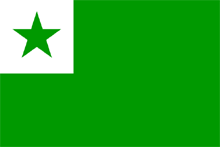What Is Esperanto?

Flag of Esperanto
|
Esperanto is the most widely spoken constructed international auxiliary language. Its name derives from Doktoro Esperanto, the pseudonym under which L. L. Zamenhof published the first book detailing Esperanto, the Unua Libro, in 1887. The word esperanto means "one who hopes" in the language itself. The language's original name was "La Internacia Lingvo". Zamenhof's goal was to create an easy to learn and politically neutral language that would serve as a universal second language to foster peace and international understanding. Esperanto has approximately one thousand native speakers, i.e. people who learned Esperanto as one of their native languages from their parents. There is controversy over the number of people who are fluent in Esperanto. Estimates range from 10,000 to as high as two million. The users are spread in about 115 countries.
Although no country has adopted the language officially, Esperanto was officially recognized by UNESCO in 1954. Today, Esperanto is employed in world travel, correspondence, cultural exchange, conventions, literature, language instruction, television, movies, and radio broadcasting. The first international Esperanto congress was organized in France, Boulogne-sur-Mer, in 1905. Since then international conferences and meetings have been organized around the world with Esperanto every year. At least one major search engine, Google, offers searching of Esperanto-related websites via an Esperanto portal.
There is evidence that learning Esperanto may provide a good foundation for learning languages in general. Esperanto is also the language of instruction in one university, the Akademio Internacia de la Sciencoj in San Marino.
|